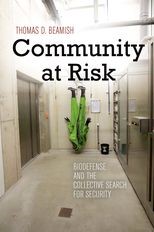Community at Risk: Biodefense and the Collective Search for Security
Community at Risk: Biodefense and the Collective Search for Security
Cite
Abstract
The anthrax attacks of 2001 provoked deep concern and urgency among U.S. security elites regarding bioterrorism. Coming after 9/11 and followed by the successive menace of West Nile virus, SARS, avian influenza, and most recently Ebola these events prompted the federal government to pursue an aggressive new biodefense agenda. Even given the purported menace of bio-catastrophe, however, the new federal risk management plans stirred controversy. Community at Risk provides a comparative view of that controversy as it ensued in three communities where universities sought to host and manage National Biocontainment Laboratories (NBL) on behalf of the federal government. NBLs are a cornerstone of federal biodefense plans; they are ultrasecure laboratories where research on the most dangerous diseases can be conducted and microbiological and biomedical applications can be rapidly developed and deployed. By comparing community responses, the book highlights the role that local civic political dynamics play in defining what is at stake and perceptions of acceptable and unacceptable risk. It explains the civic politics of risk as rooted in locally shared governance conventions, politicized relations, and resonant virtues that clustered in each community context as a prevailing civics and discourse. In one community, the prevailing civics and discourse helped to ease locals toward acceptance, while in the other two communities, they helped to intensify skepticism and risk dispute. Through comparative analysis, the book shows why societal attempts to manage risk require greater attention to the local level where public understanding is often forged and political engagement arises and unfolds.
-
Front Matter
-
Introduction
-
1
Conceptual Footings of Risk and Governance
-
2
Risk Communication, Local Civics, and Discourse
-
3
Davis, California: Home Rule Civics and Biodefense
-
4
Roxbury, Massachusetts: Direct Action Civics and Biodefense
-
5
Galveston, Texas: Managed Civics and Biodefense
-
Conclusion: The Civic Politics of Risk
-
End Matter
Sign in
Personal account
- Sign in with email/username & password
- Get email alerts
- Save searches
- Purchase content
- Activate your purchase/trial code
Institutional access
-
Sign in through your institution
- Sign in with a library card Sign in with username/password Recommend to your librarian
Institutional account management
Sign in as administratorPurchase
Our books are available by subscription or purchase to libraries and institutions.
Purchasing information| Month: | Total Views: |
|---|---|
| September 2023 | 4 |



Get help with access
Institutional access
Access to content on Oxford Academic is often provided through institutional subscriptions and purchases. If you are a member of an institution with an active account, you may be able to access content in one of the following ways:
IP based access
Typically, access is provided across an institutional network to a range of IP addresses. This authentication occurs automatically, and it is not possible to sign out of an IP authenticated account.
Sign in through your institution
Choose this option to get remote access when outside your institution. Shibboleth/Open Athens technology is used to provide single sign-on between your institution’s website and Oxford Academic.
If your institution is not listed or you cannot sign in to your institution’s website, please contact your librarian or administrator.
Sign in with a library card
Enter your library card number to sign in. If you cannot sign in, please contact your librarian.
Society Members
Society member access to a journal is achieved in one of the following ways:
Sign in through society site
Many societies offer single sign-on between the society website and Oxford Academic. If you see ‘Sign in through society site’ in the sign in pane within a journal:
If you do not have a society account or have forgotten your username or password, please contact your society.
Sign in using a personal account
Some societies use Oxford Academic personal accounts to provide access to their members. See below.
Personal account
A personal account can be used to get email alerts, save searches, purchase content, and activate subscriptions.
Some societies use Oxford Academic personal accounts to provide access to their members.
Viewing your signed in accounts
Click the account icon in the top right to:
Signed in but can't access content
Oxford Academic is home to a wide variety of products. The institutional subscription may not cover the content that you are trying to access. If you believe you should have access to that content, please contact your librarian.
Institutional account management
For librarians and administrators, your personal account also provides access to institutional account management. Here you will find options to view and activate subscriptions, manage institutional settings and access options, access usage statistics, and more.